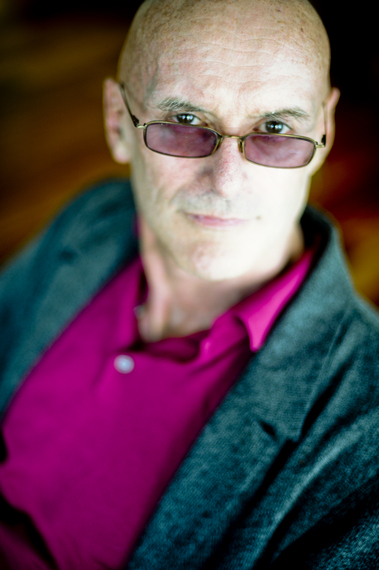by Arjuna Ardagh: It is extremely hard to imagine that a little more than 500 years ago everybody believed that the planets all revolved around the earth,

albeit in a rather chaotic and unpredictable way. Our ancestors also assumed that the world was flat, and so the greatest problem remaining to be solved, back in the 16th century, was what to do when ships exploring for new territories might fall off the edge of the earth.
All of that changed when one man, Nicolaus Copernicus, was willing to think outside the box. Copernicus came up with the revolutionary never-before-thought-idea that perhaps the earth is not the center of everything, but simply an object like many others rotating around the sun. Copernicus was largely ignored in his lifetime: ridiculed and excommunicated from the church. It took the discoveries of Galileo (who was also excommunicated) to bring Copernicus’s theories into wider acceptance. Even then it didn’t happen all at once, it wasn’t straight from obscurity to the front page of People magazine. This new way of seeing things spread slowly, one intelligent mind to another, throughout Western Europe until, by 1600, we were all headlong into the Renaissance.
This one pivotal idea, that the earth is traveling around the sun, rather than vice-versa, was not just about astronomy, it was about a new and coherent view of reality. Suddenly everything make sense: we were no longer pawns at the whim of a distracted deity with a serious case of ADHD. Now we could understand that we live in a coherent universe where things make sense. Copernicus’s revolutionary thinking opened the doors for modern science, for humanitarianism, for an explosion of creativity in art and architecture and literature.
There was a period, back then in the late 16th century, when you could live with one foot in the old world, and one in the new. You could subscribe to outdated superstition, or, with a little open mindedness and a little discipline, you could educate yourself into the wonders of reality as it is.
We are in the midst of a similar such dramatic transition from one world view to another, and in my opinion the Nicolaus Copernicus of this new renaissance is the incomparably brilliant philosopher and teacher Ken Wilber.

Duh! Yes, it is encouraging you to think outside the box. Wilber’s work is so revolutionary, so different, that it requires a little mental effort on our part. But believe me, it is really worth that effort, because it catapults us into a glorious new world where everything makes sense, where all the puzzle pieces finally fit together into a coherent whole.
I am going to share with you here the very condensed essence of five important and brilliant ideas, many of which by now have entered into common understanding, which Wilber’s work is responsible for midwifing over the last few decades.
One. While we may experience peak states from time to time, we grow through stages of evolution.
This is huge. Back in the 70’s several Indian teachers came to the west suggesting that if you simply drop into more quiet state of consciousness twice a day, that is the beginning, the middle, and the end of evolution. Hopefully by now, 30 or 40 years later, we have all understood that is blatantly not true. More expanded peak states may be essential for evolution to take place, but on their own they are nothing more than a quick high: irrelevant. Ken’s work is probably the most important force that has provoked all of us to recognize the difference between temporary peak states of consciousness and real spiritual maturity.
Two. We evolve along multiple lines of development.
Once again, within our lifetime we have seen a massive black hole of misunderstanding, where we have assumed that when someone is more developed in a particular way (for example has a facility for meditation, or healing, or “energy transfer”) that they must therefore be omniscient and infallible, and thus be the ultimate authority on every field of human development. In our folly we have often turned to celibate monks for advice about marriage, sex, or child rearing. We’ve turned to penniless philosophers to teach us about how to make money and be successful. Ken’s work frees us up from the often immature concept of “Enlightenment” as a one-size-fits-all state of arrival. It allows for a truly multi-dimensional attitude of respect towards other human beings, where you can enjoy and celebrate people for their strengths, but also have compassion and forgiveness to their weaknesses.
Three. Tools for Development are not one size fits all.
Ken Wilber’s work embraces a rich and subtle understanding of the multiple different types of people there are in the world, and more important, recognizes that an evolutionary practice or way of life for one person could be profoundly unhelpful for another. By integrating together multiple different systems of understanding (Myers Briggs, the Enneagram, etc.) Wilber has been able to map out an “operating system” which allows us to make intelligent choices about what could be most helpful in our full self-expression. The most obvious distinction that his work points to is in gender. Practices that might be extremely helpful to man, like martial arts or sitting meditation, might be less helpful for a woman, whose full unfolding might be much better served through dance, devotional practices, self-care and relaxation.
Four. What is before is not what is after.
Through the influence of Joseph Campbell, Margaret Mead and other anthropologists after World War II, we all became aware of how we may have lost our way in Western culture: emphasizing material progress and speed over connection with the earth and each other. We recognized the wisdom of learning from indigenous people from ancient traditions and cultures. With his articulation of the “pre-trans fallacy,” Wilber was the first, and perhaps the only, person to recognize that evolution cannot go backwards. A wise sage and a child may share the same qualities of wonder and innocence, but the difference that separates the two is decades of life experience and maturity. The connection to the earth that native Amazonian people may feel will always be inspiring to, but profoundly different from, a more integrated relationship to natural rhythms which also takes into account thousands of years of development and technology.
Five. We are used to viewing events and relationships through one specific window, without necessarily realizing that were doing so.
This simple recognition takes care of huge areas of misunderstanding and conflict. Wilber’s work invites us to see anything occurring in our lives, whether personal or collective, simultaneously in four distinct ways, or “quadrants.”
The first quadrant is purely subjective: It relies upon your own personal experience of things. Falling in love, having a headache and feeling disappointment are absolutely real experiences, that are validated subjectively.
The second way of seeing things is still individual, but seen objectively. It is the world of scientific validation, medical and psychological tests. The most sophisticated we become in this quadrant the most open we become to what’s going on with other people. Feeling lousy would be a personal subjective experience, while elevated temperature and heartbeat would be objectively measured, belonging to this second “quadrant.”
In the third quadrant, Wilber’s work recognizes the absolute and important validity of collective shared experience. All social movements begin in this way: our unwillingness to put up with violence against women, or child abuse, begins with a shared collective conscience and understanding, and only then translates into political and social action.
The last quadrant is collective and objective: it’s the world of sociology, global economics, and statistics. Almost every field of human exploration and understanding is enriched by the recognition of these four “quadrants,” the adoption of which frees us from narrow and exclusive thinking.
There are a couple of important caveats, which Wilber himself is emphatic about, before we can fully embrace this “Integral View.”
The first is, simply stated, that the map is not the territory. Reality is complex, multi-dimensional, and in many ways delightfully mysterious. All mapping, like integral theory, can never capture the vastness of life-as-it-is.
While Ken may be the greatest cosmologist since Copernicus, he is also a very real and authentic human being, a fact often overlooked in appraisals of his work. One of his greatest books, “Grace and Grit,” tells the story of the death of his young wife Treya from cancer. It is there that we get a window into the huge heart behind the multi-dimensional mind.
The second caveat is that Integral theory only really comes into full relevance and power once it translates into practice. Wilber’s books on their own could leave us with a massively inflated brain, and withering limbs and genitals. It’s only by applying these principles rigorously in every aspect of life that they translate into a more integrated and loving human being. For example, our own work, Awakening Coaching, is thoroughly informed by integral theory.
You have almost certainly already had your world profoundly shaken by the staggering insights of Ken Wilber. The impact of his work can be found everywhere. An entire department at JFK University in Oakland is dedicated to his work.
In my opinion it is really worth taking the time to translate this indirect influence into a direct one. Here are two highly recommended next steps:
One, Best Wilber book to get started with: A Brief History of Everything. This is not Calvin and Hobbs, people, it takes firing up the brain cells. But if you are willing to pay attention, I guarantee that it will rock your world.
So there you have it. If sometimes you still find yourself frustrated by things similar to the erratic way the planets zig zag around in the skies, or what will happen if ships fall off the edge of the flat earth, it may be time to upgrade your operating system, and tune in to the incomparable brilliance of our modern day Copernicus.








































